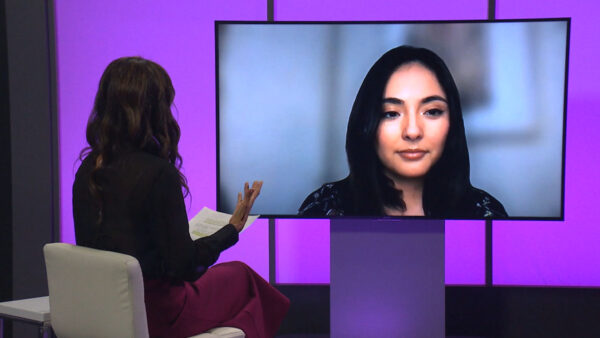Torres Marquez Communications and three valley artists Pablo Luna, Lalo Cota, and Tato Caraveo, also known as PLATO have teamed up to highlight the issue of immigration reform. CEO and Owner of Torres Marquez Communications, Tania Torres Marquez, and one of the artists Pablo Luna, discuss the details.
Jose Cardenas: As the house gets ready to debate legislation on immigration reform, a valley business and three local artists have come together to highlight the issue. We'll talk to some of the people involved with this in a moment, but first here's a look at some of the artists' work that is being called "Reformart." Joining me now is Tania Marquez, owner and CEO of Torres Marquez Communications. Also here is one of the artists, Pablo Luna. Pablo, if you regularly move as quickly as did you in the video, I think the Phoenix sun was like to talk to you. Before we talk about your basketball career, Tania, you're the originator of this Reformart as you call it. Tell us what led to this.
Tania Torres-Marquez: What's led to this, well, we've all seen the headlines lately being dominated by comprehensive immigration reform. We all have a personal story, in terms of my staff, as to why we support comprehensive immigration reform, for me I'm the owner of a small business, and I'm also the daughter of immigrant parents, if it wasn't for immigration reform in 1986, there is not much that would separate myself from a dreamer. I was born in Mexico and because of immigration reform in 1986 I was able to obtain my legal status. I was brought to this country by my parents at two weeks old. But since then I've been able to contribute to this country, I'm proud to say, in several different ways. So for me, drawing attention to the economic impact of immigration reform is a personal mantra, and it's very important for me and my team that people understand that in addition to all of the social issues that come with immigration reform, there's also the business impact that could impact several different businesses and the economy in this country.
Jose Cardenas: How do you hope to get that message across?
Tania Torres-Marquez: We're doing it in several different ways. The umbrella behind all of it is called Reformart, which is the business community and the art community coming together to draw attention to this important cause. Torres Marquez Communications is the brainchild behind this concept. We are having ads in different publications, encouraging people to call their elected officials in support of this issue, but the one unifying message is that comprehensive immigration reforms, when you look at the numbers, the numbers add up. If provided a path to citizenship to 11 million undocumented immigrants, it would provide a communicative $832 billion over the next 10 years to this country. As those 11 million continue to earn more wages, they're going to spend more money on cell phones, more money on cars, more money on homes, and that in turn strengthens the economy and it also strengthens several different businesses in this country.
Jose Cardenas: So it makes sense from a business perspective. Why art as a means of communication?
Tania Torres-Marquez: There's the old adage that art -- A picture is worth a thousand words. This case, a picture is worth the plight of 11 million in my view. Art is a subjective art form, but it's also a way to tell the story that can be complicated. But it is the platform we're using to tell this important message of the economic impact of immigration reform.
Jose Cardenas: You selected three local artists to communicate this message.
Tania Torres-Marquez: That's correct. We are very lucky to be working with three renowned Latino artists, one of them is Pablo Luna, who is here with us. They have a great following, you'll see a lot of their art throughout the city. They all have very fascinating backgrounds themselves, and they have themselves contributed a lot to this country as well.
Jose Cardenas: Pablo, let's talk about the work that you did. But first, your own interest interesting story and why this is an issue of importance to you.
Pablo Luna: Well, it's important to me because I'm -- My father is an immigrant himself, moved here from Mexico, and he is also a small business owner before, and growing up in my family, we grew up more on the Mexican side --
Jose Cardenas: Your mother is American.
Pablo Luna: Irish-Polish, yes. But she -- We all had to live in Mexico so my dad could get his papers fix and things. But basically just my whole life has been based on more of a Latino-Mexican nationalist kind of approach. Things like that, you know.
Jose Cardenas: Let's talk about what you were trying to show, and the one piece we had, you were moving around so quickly on the screen in the video, but I think we've got a still picture of that so people won't have --
Pablo Luna: It was probably a speed camera, I'm not really that fast.
Jose Cardenas: We'll get a picture of your mural on the screen. That's you working on it right there. Tell us what you were trying to do. Do the images mean?
Pablo Luna: I was trying to in my way I was trying to paint something that would incorporate both the Mexican people and the people in America, and that's why I used the green birds that represent Mexico, and I had the blue --
Jose Cardenas: The traditional Mexican bird.
Pablo Luna: Yes. And then the blue Jay for the American bird, which is an iconic symbol in America also, and the center I have the hands that represent like struggle from both sides, they both equally want to work hard and go for that dream, and I have the sun up there, kind of like the Aztec style sun and the regular sun, which is -- We all share the same sun.
Jose Cardenas: Showing a real merger of cultures.
Pablo Luna: Yeah, like --
Jose Cardenas: Give us your thoughts on a couple of the other pieces by your fellow artists. We have one that has two very prominent historical figures in Mexico and U.S. history, and on the left the President Juarez of Mexico, and President Lincoln.
Pablo Luna: It's a very good depiction. He has the people in the middle, which represent the people who are here that want to stay here and continue living here, 11 million, and those characters he did to -- Describe, to show there's -- The iconic figures in America is Abraham -- They're both great men that did great things and the people in the center represent the people who are here ready to work hard, and some of them striving to be iconic figures also.
Jose Cardenas: The last one, give us your thoughts on that particular piece.
Pablo Luna: His piece, it has the hands that represent the hard working immigrant, the hard working men, and it has -- It's also symbolizes praying, praying to be like an American citizen someday, it's got the flag in the background, and it has -- You can see the silhouette of the family all holding hands.
Jose Cardenas: As if these people are crossing the border.
Pablo Luna: Maybe they're crossing, maybe they're just standing somewhere, but it's just to convey that idea that -- That message that these are humble people that just want to make a meager life, get ahead in the world, you know, and that's all they want. They don't want to be -- They don't want to cause trouble, they just want to be here.
Jose Cardenas: Tania, when you do these events, and as I understand what you've done, you have the artists work on these events in public places, the pieces themselves will be on display in your office building, right?
Tania Torres-Marquez: Yes. They are on display during the rest of the summer. We do anticipate a lot of debate coming up in the house on comprehensive immigration reform. So this artwork in addition to other artwork will be on display at Sixth Avenue gallery, which is located on the basement level of Torres Marquez Communications. And it's locate the on sixth Avenue and McKinley, so people are welcome to give us a call and we can set up private tours. It is important to highlight that the pieces that you saw on the screen are not finished pieces. Those were unveiled just this last Friday during an art exhibit. So if you'd like to see the final artwork, please give us a call.
Jose Cardenas: And there are a total of six.
Tania Torres-Marquez: Yes.
Jose Cardenas: Let me ask you this, people might say you're just preaching to the choir. Do you really expect with these messages, and the audiences, people looking at them, to actually persuade anybody to change their mind and somebody who wasn't supporting immigration reform now will?
Tania Torres-Marquez: That's a great question. I have -- The reason why we decided to do this in the first place is because the economic impact message I feel has not gotten enough of a play. In talking to non-Latino and talking to other small business owners, they really have no idea about these numbers.
Jose Cardenas: Even though you may be preaching to the converted, you're giving them information that they can then use.
Tania Torres-Marquez: Exactly. That they can then educate others and make others aware.
Jose Cardenas: And on that note we're going to have to end our interview. Thank you both for joining us on "Horizonte." That is our show for tonight. From all of us here at "Horizonte," I'm José Cárdenas. Have a good evening.
Tania Torres Marquez:CEO & Owner, Torres Marquez Communications;Pablo Luna:Artist;























